Exhibitions, Projects
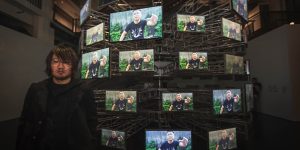
Rêverie Reset
Yan Lei (CN)
Rêverie Reset is a system that expands on Yan Lei’s practice of dissolving images into concepts. A large-scale installation makes use of cutting-edge computational systems and networking technologies in order to reaffirm the artist’s notion of the artificiality of representation and the irrelevance of the image.
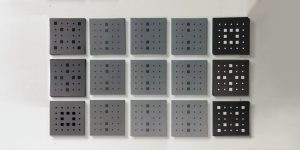
ZeroX
Hakan Lidbo (SE)
A strategic board games in 3 layers. Any piece can become any other piece.

The Generative Adversarial Network
Wesley Lee Yang (BR)
Democratization of technology and information has not been the means of liberation and empowerment as it could have been. As described and discussed by the Frankfurt School of Critical Theory, these developments have been co-opted to become mostly a means of commercial exploitation. These manipulation processes have moved from mass media to the internet and to the smart devices that are pervasive in our lives. Even when we don’t want them, it is impractical to function in society without owning and operating them. Adding insult to injury, not only are we exchanging our privacy, freedom and the health of our planet to devices that bring us convenience and comfort, but also doing it to have access to useless features, many of which create new problems for us—so that we will need or want the next “innovation.”

The Hudson
Maria Marshall (CH/UK)
Men in suits and ties carrying briefcases appear on the Hudson River and walk onto the beach and beyond the frame. Their clothes are wet. The same men appear with dry clothes and walk out of frame. The soundtrack is of a Trump speech about putting up the wall, sped-up to sound like Mickey Mouse. The soundtrack: Three of the same soundtracks are played at different intervals so that there will be a cacophony of sound, but audible wherever the viewer stands.
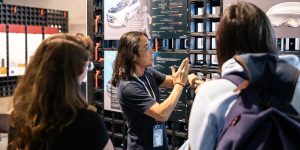
Infusing Empathy in Self Driving Cars Through Anime Expressions
Yuki Moriyama (JP), Eiji Kawata (JP), Ryohei Fukushi (JP)
In collaboration with Japanese animation studio Polygon Pictures, Mercedes-Benz has designed animations of different scenarios in which autonomous vehicles could build informed trust with humans. The basic idea when designing animes is that a lot of emotion is expressed in a few strokes. The key issue that this project concerns itself with is therefore: How can these basic principles be used for intuitive communication between human and machine?
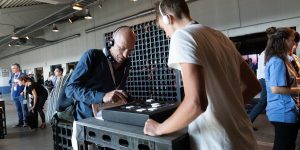
X+N
Hakan Lidbo (SE)
*X+N* is a board game where pieces and board re-build, split, morph, change size, shape and properties throughout the game.
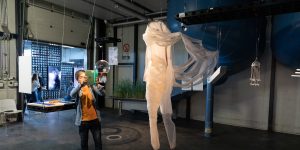
Space Exploration Initiative
MIT Media Lab (US), Xin Liu (CN)
In the past, the desire for exploration and expansion had a profound impact on how we imagined planetary futures. What shall we imagine now? In this exhibition, six projects from the Space Exploration Initiative of MIT Media Lab are asking the same question and bringing possibilities to the (im)possible space: All the projects were successfully deployed and performed in a zero-gravity parabolic flight last year. They are hopes beyond solutions, imaginations, more than facts.

Estuary Poem for Wyndham Lewis
Robert Montgomery (UK)
A memorial fire poem to Wyndham Lewis at the point where the River Thames, after leaving London, meets the North Sea. This work is both a ceremonial elegy to Lewis (an important figure in British Modernism and the editor of the concrete poetry journal BLAST) and an updating of his phrase “Enemies of the Stars” for the age of ecological crisis. It seems we have all in the age of ecological crisis become enemies of the icebergs and the stars…
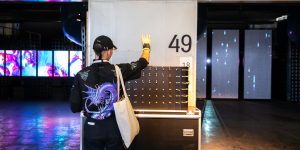
Groove – Motion as a Language
Studio 7.5 (DE)
This project investigates the communicative potential of reactive surfaces and focuses on the collaboration between humans and autonomous vehicles. The membrane perceives and reacts to the environment like a sea anemone. The aim of the project is to use these expressive possibilities to transmit processes and intentions of an autonomous system to the environment.
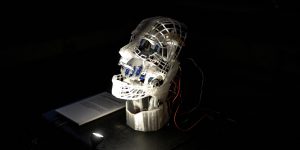
VALIS
Digital Research Unit in Art and Design at the Esad Saint-Étienne/Ensba Lyon
For this first presentation in the framework of Ars Electronica, we chose to explore concepts of “science-fiction,” considered as a domain that provides forms but also imaginary elements to be renewed. The exhibition presented here is therefore a first approach which summons various references to fields such as archeology, music, robotics or video games, passing through several experiments with media (code, 3D, sound, performance, deep learning …). VALIS “Vast Living Intelligent System” is a reference to the late work of Philip K. Dick.


